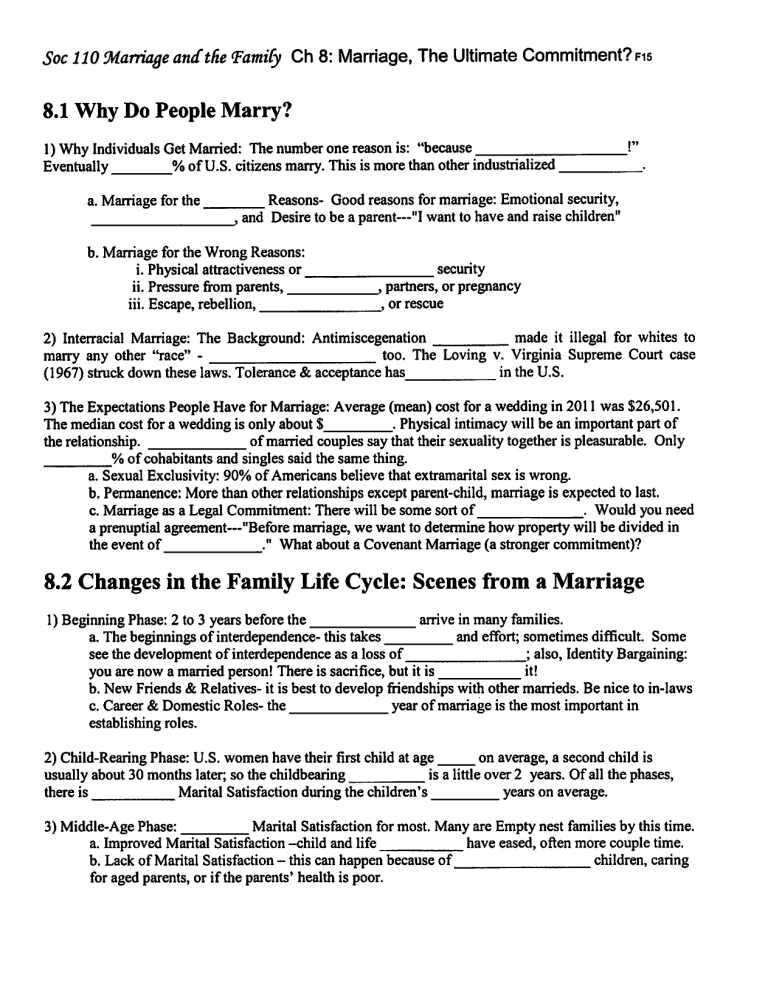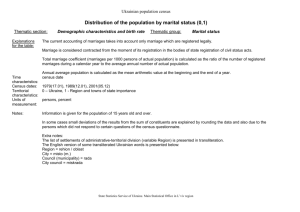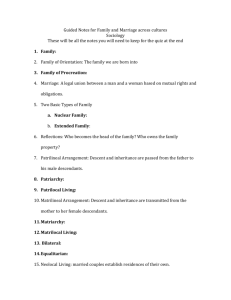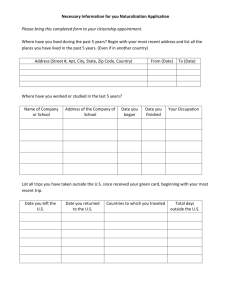8.1 Why Do People Marry? 8.2 Changes in the Family Life Cycle

Soc 110 Marriage andthe <Famify Ch 8: Marriage, The Ultimate Commitment? fis
8.1 Why Do People Marry?
1) Why Individuals Get Married: The number one reason is: "because
Eventually % of U.S. citizens marry. This is more than other industrialized a. Marriage for the Reasons- Good reasons for marriage: Emotional security,
, and Desire to be a parent—"I want to have and raise children"
!"
.
b. Marriage for the Wrong Reasons: i. Physical attractiveness or ii. Pressure from parents, iii. Escape, rebellion, security
, partners, or pregnancy
, or rescue
2) Interracial Marriage: The Background: Antimiscegenation made it illegal for whites to marry any other "race" too. The Loving v. Virginia Supreme Court case
(1967) struck down these laws. Tolerance & acceptance has in the U.S.
3) The Expectations People Have for Marriage: Average (mean) cost for a wedding in 2011 was $26,501.
The median cost for a wedding is only about $ . Physical intimacy will be an important part of the relationship.
ofmarried couples say that their sexuality together is pleasurable. Only
% of cohabitants and singles said the same thing.
a. Sexual Exclusivity: 90% of Americans believe that extramarital sex is wrong.
b. Permanence: More than other relationships except parent-child, marriage is expected to last.
c. Marriage as a Legal Commitment: There will be some sort of . Would you need a prenuptial agreement—"Before marriage, we want to determine how property will be divided in the event of ." What about a Covenant Marriage (a stronger commitment)?
8.2 Changes in the Family Life Cycle: Scenes from a Marriage
1) Beginning Phase: 2 to 3 years before the a. The beginnings of interdependence- this takes arrive in many families.
and effort; sometimes difficult. Some see the development of interdependence as a loss of you are now a married person! There is sacrifice, but it is
; also, Identity Bargaining: it!
b. New Friends & Relatives- it is best to develop friendships with other marrieds. Be nice to in-laws c. Career & Domestic Roles- the year ofmarriage is the most important in establishing roles.
2) Child-Rearing Phase: U.S. women have their first child at age usually about 30 months later; so the childbearing on average, a second child is is a little over 2 years. Of all the phases, there is Marital Satisfaction during the children's years on average.
3) Middle-Age Phase: Marital Satisfaction for most. Many are Empty nest families by this time.
a. Improved Marital Satisfaction -child and life have eased, often more couple time.
b. Lack of Marital Satisfaction - this can happen because of children, caring for aged parents, or if the parents' health is poor.
8.3 Different Kinds of Marriage Relationships
1) Five Types of Enduring Marriages: (Cuber & Harroffs Research) Which would you want to develop?
a. Utilitarian Marriages: Three Types of Unions Based more on convenience i. Conflict-habituated marriages—"We live in state of ii. Devitalized marriages—started out well, but now there is no conflict." left in the marriage iii. Passive-congenial marriages— "Our marriage is mostly practicality, not ." b. Intrinsic Marriages: Two types which are more likely to have higher marital satisfaction.
i. Vital marriages % of all marriages: Vital is what most people want!
ii. Total marriages 5% of all marriages: Total is not necessarily , but can be.
2) Four Types of "Good Marriages" from Wallerstein & Blakeslee's Research a. The Marriage: "Our Passion Will Last Forever" b. The Marriage: "We're Making Up for Past Unhappiness" c. The Companionate Marriage is a Equal, Egalitarian Relationship" d. The Traditional Marriage: "we are mostly coworkers, but there are happy times too."
8.4 What makes for a Marriage?
National poll results to this question are: 1. being in
3.
Able to talk about
2.
4. Keep the romance alive.
fidelity.
5. Able to see the side of things.
1) Good Marriages: What does research say will develop good marriages?
a. Similar : Homogamy; successful marriage partners tend to be similar.
b. Commonalities: Similar characteristics & .
1. Similar temperaments, 2. Shared sides. 4. Similar views on raising c. Economic Status, Work, & Two-paycheck Couples
1 .When both work—the negative: a double children
, 3. Strong family ties on
.
of frustrations, less companion time, less time and influence with the children.
2. When both work—the positive: more money (usually. Sometimes it can d. Domestic Work & Child Care: The higher a man is more!)
, the more likely he is to help with the housework. Arlie Hoschild's book: "The most of the housework when both spouses work?
Shift" workers: Who does
.
The Importance of Equity & Equality.
1. Agreement on
2. Agreement on
3. Setting of standards- how
.
: When will the chore be done?
should the chore be done.
2) Your Personal Journey to Marriage Success a. Commitment- dependability shown over a period of time.
b. Acceptance & Caring- accepting of c. Flexibility- people are constantly for who they are.
and your spouse is no different.
1. Static- they
2. Flexible- allows for, and even each other to remain the same.
, growth and development.
d. Vow Renewals & Personal Marriage Agreements
1. Vow renewals- When might a vow renewal be
2. Personal marriage
?
: a more formal, written list of expectations.






